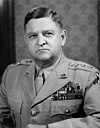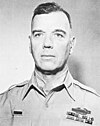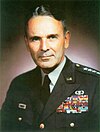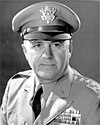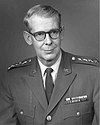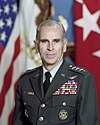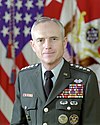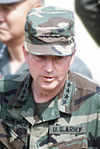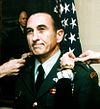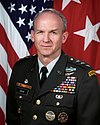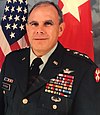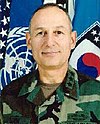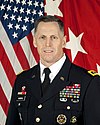Eighth United States Army
This article needs additional citations for verification. (April 2008) |
| Eighth Army | |
|---|---|
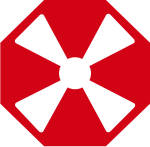 Eighth Army Shoulder Sleeve Insignia | |
| Active | 1944–present |
| Country | |
| Branch | |
| Type | Field Army |
| Role | Headquarters |
| Part of | |
| Garrison/HQ | Camp Humphreys |
| Motto(s) | Pacific Victors |
| Colors | White and red |
| Campaigns | World War II Korean War
|
| Commanders | |
| Current commander | Lt. Gen. Willard M. Burleson III |
| Notable commanders | Lt. Gen. Robert Eichelberger Lt. Gen. Walton H. Walker Lt. Gen. Matthew Ridgway Lt. Gen. James Van Fleet Lt. Gen. Maxwell D. Taylor |
| Insignia | |
| Distinctive insignia |  |
| Flag |  |
| NATO Map Symbol (1997) |  |
The Eighth Army is a U.S. field army[1] which is the commanding formation of all United States Army forces in South Korea. It commands U.S. and South Korean units[1] and is headquartered at the Camp Humphreys,[2] in the Anjeong-ri of Pyeongtaek, South Korea. It is the only field army in the U.S. Army.[3]
History[]
World War II[]
The unit first activated on 10 June 1944 in the United States, under the command of Lieutenant General Robert Eichelberger. The Eighth Army took part in many of the amphibious landings in the Southwest Pacific Theater of World War II, eventually participating in no less than sixty of them. The first mission of the Eighth Army, in September 1944, was to take over from the U.S. Sixth Army in New Guinea, New Britain, the Admiralty Islands and on Morotai, in order to free up the Sixth Army to engage in the Philippines Campaign (1944–45).
The Eighth Army again followed in the wake of the Sixth Army in December 1944, when it took over control of operations on Leyte Island on 26 December. In January, the Eighth Army entered combat on Luzon, landing the XI Corps on 29 January near San Antonio and the 11th Airborne Division on the other side of Manila Bay two days later. Combining with I Corps and XIV Corps of Sixth Army, the forces of Eighth Army next enveloped Manila in a great double-pincer movement. Eighth Army's final operation of the Pacific War was that of clearing out the southern Philippines of the Japanese Army, including on the major island of Mindanao, an effort that occupied the soldiers of the Eighth Army for the rest of the war.
Occupation of Japan[]
Eighth Army was to have participated in Operation Downfall, the invasion of Japan. It would have taken part in Operation Coronet, the second phase of the invasion, which would have seen the invasion of the Kantō Plain on eastern Honshū. However, the Japanese surrender cancelled the invasion, and the Eighth Army found itself in charge of occupying it peacefully. Occupation forces landed on 30 August 1945, with its headquarters in Yokohama, then the HQ moved to the Dai-Ichi building in Tokyo. At the beginning of 1946, Eighth Army assumed responsibility for occupying all of Japan. Four quiet years then followed, during which the Eighth Army gradually deteriorated from a combat-ready fighting force into a somewhat soft, minimally-trained constabulary. Lieutenant General Walton H. Walker took command in September 1948, and he tried to re-invigorate the Army's training, with mixed success.
Korean War[]
At the end of World War II in 1945, Korea was divided into North Korea and South Korea with North Korea (assisted by the Soviet Union),[4] becoming a communist government after 1946, known as the Democratic People's Republic, followed by South Korea becoming the Republic of Korea.[5] China became the communist People's Republic of China in 1949. In 1950, the Soviet Union backed North Korea while the United States backed South Korea, and China allied with the Soviet Union in what was to become the first military action of the Cold War.[5][6]

The peace of occupied Japan was shattered in June 1950 when 75,000 North Korean troops with Russian made tanks invaded South Korea, igniting the Korean War.[5][7] U.S. naval and air forces quickly became involved in combat operations, and it was soon clear that U.S. ground forces would have to be committed. To stem the North Korean advance, the occupation forces in Japan were thus shipped off to South Korea as quickly as possible, but their lack of training and equipment was telling, as some of the initial U.S. units were destroyed by the North Koreans. However, the stage was eventually reached as enough units of Eighth Army arrived in Korea to make a firm front. The North Koreans threw themselves against that front, the Pusan Perimeter, and failed to break it.
Eighth Army arrived in July 1950 and never left. —Lt. Gen. Thomas S. Vandal, CG, Eighth Army, 29 August 2017[8]
In the meantime, Eighth Army had reorganized, since it had too many divisions under its command for it to exercise effective control directly. The I Corps and the IX Corps were reactivated in the United States and then shipped to Korea to assume command of Eighth Army's subordinate divisions.
The stalemate was broken by the Inchon landings of the X Corps (tenth corps, consisting of soldiers and Marines). The North Korean forces, when confronted with this threat to their rear areas, combined with a breakout operation at Pusan, broke away and hastily retired north.

Both South and North Korea were almost entirely occupied by United Nations forces. However, once U.S. units neared the Yalu River and the frontier between North Korea and China, the Chinese intervened and drastically changed the character of the war. Eighth Army was decisively defeated at the Battle of the Chongchon River and forced to retreat all the way back to South Korea. The defeat of the U.S. Eighth Army resulted in the longest retreat of any U.S. military unit in history. General Walker was killed in a jeep accident on 23 December 1950, and replaced by Lieutenant General Matthew Ridgway. The overstretched Eighth Army suffered heavily with the Chinese offensive, who were able to benefit from shorter lines of communication and with rather casually deployed enemy forces. The Chinese broke through the U.S. defenses despite U.S. air supremacy and the Eighth Army and U.N. forces retreated hastily to avoid encirclement. The Chinese offensive continued pressing U.S. forces, which lost Seoul, the South Korean capital. Eighth Army's morale and esprit de corps hit rock bottom, to where it was widely regarded as a broken, defeated rabble.
General Ridgway forcefully restored Eighth Army to combat effectiveness over several months. Eighth Army slowed and ultimately halted the Chinese advance at the battles of Chipyong-ni and Wonju. It then counter-attacked the Chinese, re-took Seoul, and drove to the 38th parallel, where the front stabilized.
When General Ridgway replaced General of the Army Douglas MacArthur as the overall U.N. commander, Lieutenant General James Van Fleet assumed command of Eighth Army. After the war of movement during the first stages, the fighting in Korea settled down to a war of attrition. Ceasefire negotiations were begun at the village of Panmunjom in the summer of 1951, and they dragged on for two years. During the final combat operation of the war, Lieutenant General Maxwell D. Taylor (promoted to general 23 June 1953) commanded the Eighth Army. When the Military Demarcation Line was finally agreed to by the Korean Armistice Agreement, South Korea and North Korea continued on as separate states.
Guarding Korea[]

During the aftermath of the Korean War, the Eighth Army remained in South Korea. By the 1960s, I Corps, consisting of the 7th Infantry Division and the 2nd Infantry Division, remained as part of the Eighth Army. Then, in 1971, the 7th Infantry Division was withdrawn, along with the command units of I Corps, which were moved across the Pacific Ocean to Fort Lewis, Washington.[9] Later, in March 1977, a memo from President Jimmy Carter said "...American forces will be withdrawn. Air cover will be continued." Bureaucratic resistance from the Executive Branch, with support in Congress, eventually saw the proposal watered down. Eventually one combat battalion and about 2,600 non-combat troops were withdrawn.[10]
This left the 2nd Infantry Division at the Korean Demilitarized Zone to assist the South Korean Army. Besides forming a trip-wire against another North Korean invasion, the 2nd Infantry Division remained there as the only Army unit in South Korea armed with tactical nuclear weapons. (Otherwise, there is only the U.S. Air Force in South Korea and on Okinawa.) All nuclear weapons were taken from the Army to be under Air Force control. Later, all U.S. nuclear weapons were removed from South Korea.[when?]
Organization 1989[]

At the end of the Cold War Eighth Army consisted of the following units:
 Eighth Army, Yongsan Garrison, South Korea[11]
Eighth Army, Yongsan Garrison, South Korea[11]
- Headquarters & Headquarters Company
 2nd Infantry Division, Camp Casey[11]
2nd Infantry Division, Camp Casey[11] 17th Aviation Brigade, Camp Coiner[11][12][13]
17th Aviation Brigade, Camp Coiner[11][12][13]
- Headquarters & Headquarters Company
- 4th Battalion, (Air Traffic Control), Camp Coiner[13]
- 1st Battalion, 501st Aviation (Assault), Camp Coiner (UH-60A Black Hawk helicopters)[13][14]
- 2nd Battalion, 501st Aviation (Medium Lift), Camp Coiner (CH-47D Chinook helicopters)[13][15]
- 4th Battalion, 501st Aviation (Attack), Camp Page (AH-1F Cobra & OH-58C Kiowa helicopters)[13]
- 5th Battalion, 501st Aviation (Attack), Camp Coiner (AH-1F Cobra & OH-58C Kiowa helicopters)[13]
 1st Signal Brigade, Camp Humphreys[16]
1st Signal Brigade, Camp Humphreys[16]
 8th Military Police Brigade (Provisional), Camp Coiner[11]
8th Military Police Brigade (Provisional), Camp Coiner[11]
- Headquarters & Headquarters Company
- 94th Military Police Battalion[21]
- 728th Military Police Battalion[22]
 501st Military Intelligence Brigade (Provisional), Yongsan Garrison[23]
501st Military Intelligence Brigade (Provisional), Yongsan Garrison[23]
- Headquarters & Headquarters Detachment
- 3rd Military Intelligence Battalion (Aerial Exploitation), Camp Humphreys[13]
- 524th Military Intelligence Battalion (Human Intelligence)[24]
- 532nd Military Intelligence Battalion (Intelligence & Electronic Warfare)[25]
- 751st Military Intelligence Battalion (Counterintelligence), Camp Humphreys[13]
 18th Medical Command, Seoul[11][13] (the following peacetime listing is incomplete)
18th Medical Command, Seoul[11][13] (the following peacetime listing is incomplete)
- Headquarters and Headquarters Detachment
- 52nd Medical Battalion[13]
- 121st Combat Support Hospital, Camp Humphreys
 19th Support Command, Daegu[11] (the following peacetime listing is incomplete)
19th Support Command, Daegu[11] (the following peacetime listing is incomplete)
- Headquarters and Headquarters Company
- Special Troops Battalion
- 20th Area Support Group, Camp Henry[11]
- Headquarters and Headquarters Company
- 23rd Area Support Group, Camp Humphreys[11][13]
- 25th Transportation Center (Movement Control), Yongsan Garrison
- 21st Transportation Company (Command Transport), Yongsan Garrison[27]
- 46th Transportation Company, Camp Carroll
- 34th Area Support Group, Seoul[11]
- Headquarters and Headquarters Company
- 501st Corps Support Group, Camp Red Cloud[11]
- Headquarters and Headquarters Company
- 8th Personnel Command[11][28]
- 516th Personnel Service Company[29]
- 175th Finance Center[11][30]
- 23rd Chemical Battalion[33]
- 44th Engineer Battalion (Combat) (Heavy),
- 8th Army Band
Recent times[]
In 2003, plans were announced to move the 2nd Infantry Division southward. As of 2015, it appears that one brigade of the 2nd Infantry Division will remain at Camp Casey, near Dongducheon.
The headquarters of the Eighth Army was Yongsan Garrison, but moved southward to Camp Humphreys by 2019.[2] In April 2017 the Eighth Army headquarters began its move from Yongsan to Camp Humphreys and held a ceremony to relocate a statue of General Walton Walker.[34]
Current organization[]

 Eighth Army, USAG Humphreys[35][36]
Eighth Army, USAG Humphreys[35][36]
- Eighth Army Headquarters and Headquarters Battalion
- 2d Infantry Division (Joint United States and South Korean Army)
- 2d Infantry Division Combined Division Staff (Joint United States and South Korean Army)
- Headquarters and Headquarters Battalion
- Rotational Armored Brigade Combat Team
- 210th Field Artillery Brigade
- Headquarters and Headquarters Battery
- 210th Field Artillery Brigade Headquarters and Headquarters Battery
- 1st Battalion, 38th Field Artillery Regiment
- 6th Battalion, 37th Field Artillery Regiment
- Rotational M270 MLRS Field Artillery Battalion
- 70th Brigade Support Battalion
- Combat Aviation Brigade, 2d Infantry Division[37]
- Headquarters and Headquarters Company
- 2d Battalion (Assault), 2d Aviation Regiment
- 3d Battalion (General Support), 2d Aviation Regiment
- 4th Battalion (Attack), 2d Aviation Regiment
- Rotational Attack/Reconnaissance Helicopter Cavalry Squadron
- Company E, 2d Aviation Regiment (MQ-1C Gray Eagle)
- 602d Aviation Support Battalion
- 2nd Infantry Division Sustainment Brigade
- Headquarters and Headquarters Company
- Special Troops Battalion
- 194th Combat Sustainment Support Battalion
- 1st Signal Brigade, subordinate to 311th Signal Command / US Army Pacific
- Headquarters and Headquarters Company
- United States Army Communications Information Systems Activity, Pacific
- 41st Signal Battalion
- 304th Expeditionary Signal Battalion
- 19th Expeditionary Sustainment Command[38]
- Headquarters and Headquarters Company
- 94th Military Police Battalion
- Materiel Support Command Korea
- 6th Ordnance Battalion
- 25th Transportation Battalion
- 498th Combat Sustainment Support Battalion
- Korean Service Corps
- 35th Air Defense Artillery Brigade
- Headquarters and Headquarters Battery
- 2d Battalion, 1st Air Defense Artillery Regiment (Patriot)
- 6th Battalion, 52d Air Defense Artillery Regiment (Patriot)
- Battery D, 2d Air Defense Artillery Regiment (THAAD)
- 65th Medical Brigade
- Headquarters and Headquarters Company
- 549th Hospital Center
- 168th Medical Battalion (Multifunctional)
- 618th Dental Company
- 106th Medical Detachment (Veterinary Specialist Services)
- U.S. Army Medical Materiel Center – Korea
- 501st Military Intelligence Brigade
- Headquarters and Headquarters Company
- 3d Military Intelligence Battalion
- 368th Military Intelligence Battalion (US Army Reserve), at Parks Reserve Forces Training Area, California
- 524th Military Intelligence Battalion
- 532d Military Intelligence Battalion
- 719th Military Intelligence Battalion
- United Nations C Security Battalion, Joint Security Area
- Korean Field Office
- Army Special Operations Forces Liaison Element, Korea
- Joint United States Military Affairs Group, Korea
- Eighth Army Non-Commissioned Officers Academy
- Training Support Activity, Korea
- 11th Engineer Battalion, subordinate to 130th Engineer Brigade / US Army Pacific
- 23rd Chemical Battalion
- 4th Company, 58th Airfield Operations Battalion
- 2501st Digital Liaison Detachment
- 2502d Digital Liaison Detachment
- 3d Battlefield Coordination Detachment
- United States Army Corps of Engineers, Far East District
- Eighth Army Band
Other army units based in South Korea:
- 403rd Army Field Support Brigade, Camp Henry, part of Army Sustainment Command[39]
- Army Field Support Battalion - Korea
- Army Field Support Battalion - Northeast Asia
- 837th Transportation Battalion, part of / Military Surface Deployment and Distribution Command
Specific units[]
8th Army Band[]
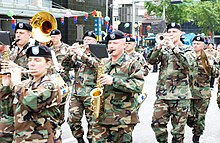
The 8th Army Band is the official musical unit of the HQ 8th Army and supports United States Forces Korea and the United Nations Command.[40] The 62 member band was founded in 1916 as the Band of the 35th Infantry Regiment. During World War II, the band, then known as the 25th Infantry Division Band based out of Hawaii, served in the Pacific Theater, being a participant in Central Pacific and Guadalcanal campaigns. It was reorganized in November 1950 and reassigned to the newly formed ROK, the same year the Korean War began.[41] Awards and honors the band has received include the Meritorious Unit Commendation and two Republic of Korea Presidential Unit Citations.[42] Nicknamed Freedom's Ambassadors due to its area of responsibility, it has performed at events such as the Wonju Tattoo, the Gangwon International Tattoo as well as Korean War memorial ceremonies in the country.[43][44] The Alliance Brass, an ensemble in the 8th Army Band, celebrated its 99th anniversary in Mongolia in June 2015 with a concert on Sükhbaatar Square.[45]
Korean Service Corps[]
The Korean Service Corps was a reserve force composed of South Korean volunteers who were augmented to the 8th Army. They provided labourers who were used to carry ammunition and supplies, and support the overall logistic elements of the army. It is today, a paramilitary civilian formation that is battalion-sized. Continuing is role as a combat service support unit, it is capable of being expanded and mobilized during a wartime situation.
List of commanders[]
| No. | Commander | Term | |||
|---|---|---|---|---|---|
| Portrait | Name | Took office | Left office | Term length | |
| 1 | Lieutenant General Robert L. Eichelberger (1886–1961) | 1 June 1944 | 4 August 1948 | 4 years, 64 days | |
| 2 | Lieutenant General Walton Walker (1889–1950) | 4 August 1948 | 23 December 1950 | 2 years, 141 days | |
| 3 | Lieutenant General Matthew Ridgway (1895–1993) | 25 December 1950 | 12 April 1951 | 108 days | |
| 4 | General James Van Fleet (1892–1992) | 14 April 1951 | 11 February 1953 | 1 year, 303 days | |
| 5 | General Maxwell D. Taylor (1901–1987) | 11 February 1953 | 25 March 1955 | 2 years, 42 days | |
| 6 | General Lyman Lemnitzer (1899–1988) | 25 March 1955 | 5 June 1955 | 72 days | |
| 7 | General Isaac D. White (1901–1990) | 25 June 1955 | 1 July 1957 | 2 years, 6 days | |
| 8 | General George Decker (1902–1980) | 1 July 1957 | 30 June 1959 | 1 year, 364 days | |
| 9 | General Carter B. Magruder (1900–1988) | 1 July 1959 | 30 June 1961 | 1 year, 364 days | |
| 10 | General Guy S. Meloy (1903–1968) | 1 July 1961 | 31 July 1963 | 2 years, 30 days | |
| 11 | General Hamilton H. Howze (1908–1998) | 1 August 1963 | 15 June 1965 | 1 year, 318 days | |
| 12 | General Dwight E. Beach (1908–2000) | 16 June 1965 | 31 August 1966 | 1 year, 76 days | |
| 13 | General Charles H. Bonesteel III (1909–1977) | 1 September 1966 | 30 September 1969 | 3 years, 29 days | |
| 14 | General John H. Michaelis (1912–1985) | 1 October 1969 | 31 August 1972 | 2 years, 335 days | |
| 15 | General Donald V. Bennett (1915–2005) | 1 September 1972 | 31 July 1973 | 333 days | |
| 16 | General Richard G. Stilwell (1917–1991) | 1 August 1973 | 8 October 1976 | 3 years, 68 days | |
| 17 | General John W. Vessey Jr. (1922–2016) | 8 October 1976 | 10 July 1979 | 2 years, 275 days | |
| 18 | General John A. Wickham Jr. (born 1928) | 10 July 1979 | 4 June 1982 | 2 years, 329 days | |
| 19 | General Robert W. Sennewald (born 1929) | 4 June 1982 | 1 June 1984 | 1 year, 363 days | |
| 20 | General William J. Livsey (1931–2016) | 1 June 1984 | 25 June 1987 | 3 years, 24 days | |
| 21 | General Louis C. Menetrey Jr. (1929–2009) | 25 June 1987 | 26 June 1990 | 3 years, 1 day | |
| 22 | General Robert W. RisCassi (born 1936) | 26 June 1990 | 1 December 1992 | 2 years, 158 days | |
| 23 | Lieutenant General William W. Crouch (born 1941) | 1 December 1992 | 18 October 1994 | 1 year, 321 days | |
| 24 | Lieutenant General Richard F. Timmons | 19 October 1994 | 31 July 1997 | 2 years, 285 days | |
| 25 | Lieutenant General Randolph W. House | 1 August 1997 | 25 September 1998 | 1 year, 55 days | |
| 26 | Lieutenant General Daniel J. Petrosky (born 1944) | 25 September 1998 | 28 September 2000 | 2 years, 3 days | |
| 27 | Lieutenant General Daniel R. Zanini | 28 September 2000 | 6 November 2002 | 2 years, 39 days | |
| 28 | Lieutenant General Charles C. Campbell (1948–2016) | 6 November 2002 | 10 April 2006 | 3 years, 155 days | |
| 29 | Lieutenant General David P. Valcourt (born 1951) | 11 April 2006 | 17 February 2008 | 1 year, 312 days | |
| 30 | Lieutenant General Joseph F. Fil Jr. (born 1953) | 18 February 2008 | 19 November 2010 | 2 years, 274 days | |
| 31 | Lieutenant General John D. Johnson (born 1952) | 9 November 2010 | 26 June 2013 | 2 years, 229 days | |
| 32 | Lieutenant General | 27 June 2013 | 2 February 2016 | 2 years, 220 days | |
| 33 | Lieutenant General | 2 February 2016 | 5 January 2018 | 1 year, 337 days | |
| 34 | Lieutenant General Michael A. Bills (born 1958) | 5 January 2018 | 2 October 2020 | 2 years, 271 days | |
| 35 | Lieutenant General Willard Burleson | 2 October 2020 | Incumbent | 353 days | |
References[]
- ^ Jump up to: a b "Enter the Dragon: Eighth Army unveils new emblem" (15 April 2013)
- ^ Jump up to: a b Yongsan garrison move pushed back to 2019 Archived 30 June 2013 at the Wayback Machine
- ^ THEATER ARMY, CORPS, AND DIVISION OPERATIONS FM 3-94. United States Army. 2014. pp. 1–2.
- ^ This Day in History, 1950, Korean War Begins
- ^ Jump up to: a b c National Archives, US Enters the Korean Conflict
- ^ History Vault, Korean War
- ^ History Vault Korean War
- ^ The National Defense Committee visits Eighth Army Headquarters (29 August 2017)
- ^ Don Oberdorfter, The Two Koreas: A Contemporary History, Addison-Wesley, 1997, p. 86.
- ^ Oberdorfer, The Two Koreas, 1997, 86-94.
- ^ Jump up to: a b c d e f g h i j k l Army - The Magazine of Landpower - January 1989 (1989). "Command and Staff". Association of the US Army. Retrieved 28 June 2020.
- ^ "17th Aviation Brigade Lineage". US Army Center of Military History. Retrieved 28 June 2020.
- ^ Jump up to: a b c d e f g h i j k l m n Colonel Johnnie L. Sheperd (1993). "Bring your Career to Korea!". US Army Aviation Digest - July / August 1993. Retrieved 28 June 2020.
- ^ "1st Battalion, 501st Aviation Lineage". US Army Center of Military History. Retrieved 28 June 2020.
- ^ "2nd Battalion, 501st Aviation Lineage". US Army Center of Military History. Retrieved 28 June 2020.
- ^ Jump up to: a b c d e Raines, Rebecca Robbins. "Signal Corps" (PDF). US Army Center of Military History. Retrieved 28 June 2020.
- ^ "36th Signal Battalion Lineage". US Army Center of Military History. Retrieved 28 June 2020.
- ^ "41st Signal Battalion Lineage". US Army Center of Military History. Retrieved 28 June 2020.
- ^ "304th Signal Battalion Lineage". US Army Center of Military History. Retrieved 28 June 2020.
- ^ "307th Signal Battalion Lineage". US Army Center of Military History. Retrieved 28 June 2020.
- ^ "94th Military Police Battalion Lineage". US Army Center of Military History. Retrieved 28 June 2020.
- ^ "728th Military Police Battalion Lineage". US Army Center of Military History. Retrieved 28 June 2020.
- ^ "501st Military Intelligence Brigade Lineage". US Army Center of Military History. Retrieved 28 June 2020.
- ^ "524th Military Intelligence Battalion Lineage". US Army Center of Military History. Retrieved 28 June 2020.
- ^ "532nd Military Intelligence Battalion Lineage". US Army Center of Military History. Retrieved 28 June 2020.
- ^ Jump up to: a b "3rd Battalion, 501st Aviation Lineage". US Army Center of Military History. Retrieved 28 June 2020.
- ^ "21st Transportation Company Lineage". US Army Center of Military History. Retrieved 28 June 2020.
- ^ "8th Personnel Center Lineage". US Army Center of Military History. Retrieved 28 June 2020.
- ^ "516th Personnel Service Battalion Lineage". US Army Center of Military History. Retrieved 28 June 2020.
- ^ "175th Financial Management Support Center Lineage". US Army Center of Military History. Retrieved 28 June 2020.
- ^ "176th Finance Company Lineage". US Army Center of Military History. Retrieved 28 June 2020.
- ^ "177th Finance Battalion Lineage". US Army Center of Military History. Retrieved 28 June 2020.
- ^ "23rd Chemical Battalion Lineage". US Army Center of Military History. Retrieved 28 June 2020.
- ^ "8th U.S. Army Starts Moving Out of Seoul". The Chosun Ilbo. 26 April 2017. Retrieved 27 April 2017.
- ^ "MSC Organization". US Eighth Army. Retrieved 19 April 2021.
- ^ [file:///C:/Users/sinwaniz/Downloads/The%20conventional%20military%20balance%20on%20the%20Korean%20peninsula.pdf p.55]
- ^ https://history.army.mil/html/forcestruc/lineages/branches/div/002idavbde.htm
- ^ "Team". 19th Expeditionary Sustainment Command. Retrieved 19 April 2021.
- ^ "403rd Army Field Support Brigade (AFSB)". Army Sustainment Command. Retrieved 19 April 2021.
- ^ "Soldier Support Journal". 1982.
- ^ "EIGHTH ARMY BAND - History".
- ^ https://8tharmy.korea.army.mil/site/about/eighth-army-band.asp
- ^ "8th Army band readies for Wonju festival".
- ^ "EIGHTH ARMY BAND - News".
- ^ "U.S. 8th Army Band's Ensemble Group, Alliance Brass Celebrates 99th Birthday in Mongolia". 30 June 2015.
- Blair, Clay (2003). The Forgotten War: America in Korea, 1950-1953 (illustrated, reprint ed.). Naval Institute Press. ISBN 1591140757. Retrieved 18 April 2014.
- Blair, Clay (12 December 1987). The forgotten war: America in Korea, 1950. Times Books. ISBN 0812916700. Retrieved 18 April 2014.
External links[]
| Wikimedia Commons has media related to Eighth United States Army. |
- Eighth Army – Official Homepage
- GlobalSecurity: Eighth Army
- The short film STAFF FILM REPORT 66-12A (1966) is available for free download at the Internet Archive
- Field armies of the United States
- Military units of the United States Army in South Korea
- Military units and formations established in 1944
- United States Army units and formations in the Korean War

